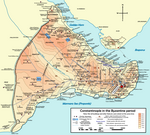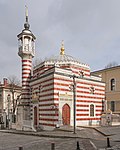Grand Post Office
Buildings and structures in IstanbulBuildings and structures of the Ottoman EmpireFatihFirst Turkish National architectureGovernment buildings completed in 1909 ... and 4 more
Office buildings completed in 1909Ottoman architecture in IstanbulPost office buildings in TurkeyVedat Tek buildings

The Istanbul Grand Post Office (Turkish: Büyük Postane), or Istanbul Main Post Office, is an office building for postal services located in the Sirkeci neighborhood of the Eminönü quarter within the Fatih district of Istanbul, Turkey. It was designed by architect Vedat Tek in First Turkish National architectural style and was constructed between 1905 and 1909. The four-story building houses a post office, the Sirkeci Post Office (Turkish: Sirkeci PTT Merkezi), office space for regional administration and also since 2000 the Istanbul Postal Museum (Turkish: PTT İstanbul Müzesi). It is Turkey's largest post office building.
Excerpt from the Wikipedia article Grand Post Office (License: CC BY-SA 3.0, Authors, Images).Grand Post Office
Muhzırbaşı Sokağı, Istanbul
Geographical coordinates (GPS) Address External links Nearby Places Show on map
Geographical coordinates (GPS)
| Latitude | Longitude |
|---|---|
| N 41.014568 ° | E 28.97414 ° |
Address
Büyük Postane
Muhzırbaşı Sokağı
34112 Istanbul
Türkiye
Open on Google Maps









